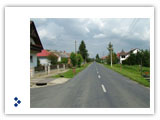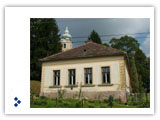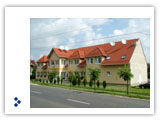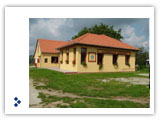General informations
- number of inhabitants: 689
- inner areas: 166 Hungarian acres
- outer areas: 1257Hungarian
acres

Communal indicators:
- number of flats: 274
- supplied with water-pipe: 100%
- supplied with gas-pipe: 43%
- supplied with telephone: 90%
- asphalt road: 100%

Institutions:
District notary
(2 Fő street Pusztamagyaród)
Kenyeres Elemér Primary and nursery school
(16 Fő street Pusztamagyaród)
Health centre
(18 Fő street Pusztamagyaród)
Post office
(20 Fő street Pusztamagyaród)
Internet house
(2 Zrínyi street Pusztamagyaród)
Social care centre
(2 Kossuth street Pusztamagyaród)

Non-profit organisations:
Fund for the Developed
Pusztamagyaród
Militian Association of
Pusztamagyaród
Sport Association of
Pusztamagyaród

Local government officials:
Kovács Károlyné
Major
(2 Fő street Pusztamagyaród
Tel. no.: 003693573021)
Árkus István
Deputy- major
(2 Fő street Pusztamagyaród
Tel. no.: 003693573021)
Szunyogh István
District notary
(2 Fő street Pusztamagyaród
Tel. no.: 003693573000)
|
|
The history of Pusztamagyaród
 The
settlement was already inhabited probably in the Stone Age. At the time
of the Hungarian conquest the former little village with a church and
a Paulite monastery in the centre was found four kilometres far from
the present one. It was first mentioned as "Moghorod" in 1214. In 1720
it was already called as Pusztamagyaród. The
settlement was already inhabited probably in the Stone Age. At the time
of the Hungarian conquest the former little village with a church and
a Paulite monastery in the centre was found four kilometres far from
the present one. It was first mentioned as "Moghorod" in 1214. In 1720
it was already called as Pusztamagyaród.
Due to the Turkish attacks in 1576, 1578, and in 1582 it was completely
devastated and burnt down. After the fall of Kanizsa city the village was
joined the chain of frontier fortresses. To stop the Turkish attack they
established a settlement in the place of the present Rákóczi street, with
a garrison, as well.
The position of the village is in line with this fact; the inhabitants
in its western part are descendants of Magyaród and the garrison having
burnt down, while those Turkish soldiers who stayed here settled in the
eastern part.
Due to several Turkish attacks the villeins paid some tax for their freedom
and peace. The settlement could have been completely destroyed in the 1680's,
it was still depopulated in 1714.
 After
the wars of liberation some laid claim to the village; lot of noble
families (Perneszy, László, Balog, Csapody, Tulok, etc.) owned most
of the land. 12 villeins and 16 cotters lived in the village in 1728.
The Keresztelő Szent János church was built in 1732 by György Zimmermann.
In 1735 three filia (Tófej, Ederics and Szentliszló) belonged to
it. The diocese in Veszprém took it over in 1736. The next year 284
inhabitants lived in 54 houses; the vicar, speaking Croatian and
German, as well, registered marriage and death certifications and
christened the people. In 1756 the vicar was Péter Madarász. After
the wars of liberation some laid claim to the village; lot of noble
families (Perneszy, László, Balog, Csapody, Tulok, etc.) owned most
of the land. 12 villeins and 16 cotters lived in the village in 1728.
The Keresztelő Szent János church was built in 1732 by György Zimmermann.
In 1735 three filia (Tófej, Ederics and Szentliszló) belonged to
it. The diocese in Veszprém took it over in 1736. The next year 284
inhabitants lived in 54 houses; the vicar, speaking Croatian and
German, as well, registered marriage and death certifications and
christened the people. In 1756 the vicar was Péter Madarász.
A teacher, József Szekeres worked in the village, too. In order to distinguish
from the other settlements called Magyaród the village got the name of
Nemes Magyaród and was part of the juditatus in Bánokszentgyörgy. In 1771
the teacher was Pál Rusa; being no students in the village he worked as
a cantor and ringer.
At the time of the socage decrees of Theresa Maria 20 Hungarian acres of
arable land, 8 pieces of meadow and six-month-right for wine measuring
belonged to a building site. They did their socage with four cattles and
gave one-ninth of the crop to the noble landowner. 590 inhabitants lived
here in 1778 and the church was under the bishopric of Szombathely.
 In
1876 the population was 638, most of them were Roman Catholic. Grape
and wine-growing became significant ensuring prosperity for some
wealthy families. According to the data four people participated
in the Hungarian Revolution and War of Independence in 1848-49: Ferenc
Cziráki, József Ludasi, Ferenc Németh, Grácián Püspöki, who flied
the Hungarian flag while recapturing the Buda Castle. After the war
he was sent in prison, his land was confiscated. In
1876 the population was 638, most of them were Roman Catholic. Grape
and wine-growing became significant ensuring prosperity for some
wealthy families. According to the data four people participated
in the Hungarian Revolution and War of Independence in 1848-49: Ferenc
Cziráki, József Ludasi, Ferenc Németh, Grácián Püspöki, who flied
the Hungarian flag while recapturing the Buda Castle. After the war
he was sent in prison, his land was confiscated.
In 1887 Károly Kenyeres was the teacher and cantor of the village, his
son was Elemér Kenyeres Phd.writer. After the Compromise of 1867 district
notary was the administrative form headed by Simon.
The population was rising; 1152 inhabitants lived here in 1890.
István Nagy landowner, MP was born in the village. He was running his farm
in Pusztamagyaród from 1907. He owned 520 Hungarian acres of land. He became
an MP in 1933.
Directorate was founded in 1919; the members were: József Busa, Imre Szabó,
János Tóth, Pál Istiván. In 1935 the district of the settlement was 2882
Hungarian acres of land. The land distributing committee was established
on 8 April, 1945. The members were: János Pete, Mihály Számpli, István
and János Karakai. 55 farmers were given land and registered as owners.
The "tsz" (a kind of agricultural community in the communist era) was founded
in 1948.
 In
the same year the primary school was taken into public ownership, four
teachers and 174 students worked there. After 6 years a nursery school
was established and the primary school was enlarged with some new classrooms.
These two schools operated until 2001. From the 1950's a new culture house,
a cinema and a library were available, as well. The Common Council-headed
by József Busa- was established in 1950. In
the same year the primary school was taken into public ownership, four
teachers and 174 students worked there. After 6 years a nursery school
was established and the primary school was enlarged with some new classrooms.
These two schools operated until 2001. From the 1950's a new culture house,
a cinema and a library were available, as well. The Common Council-headed
by József Busa- was established in 1950.
The Keresztelő Szent János church was renovated in 1974. This gabled building
with towers was declared a historic monument as well as the Szent Flórián
chapel in the cemetery. The little building with wooden ceiling was built
in the first half of the 18 century; it was badly damaged by 1778. In 1782
they started to build the present church that was completely carried out
around 1830. In 1924 the shingle was changed to slate roof, the interior
was renovated in 1939, the outside was restored in 1964. Both churches
are Roman Catholic.
Health care service is ensured by a doctor and a health visitor.
|







